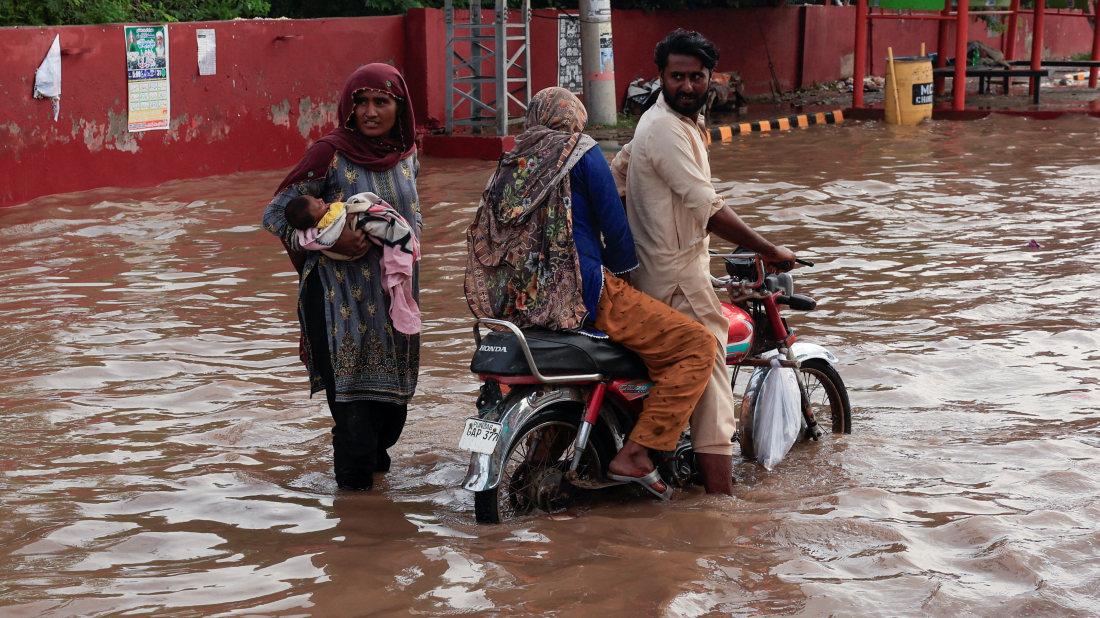Renee Nicole Good: Conflicting accounts threaten to overshadow fatal shooting of U.S. woman
Competing versions of what led to the fatal shooting of Renee Nicole Good by an Immigration Customs Enforcement agent are rife as President Trump and ...

At least 23 people have died in the past 24 hours in Punjab province, Pakistan, after heavy monsoon rains triggered severe flooding, officials said.
Authorities warned that further heavy rainfall is expected in Islamabad and various regions of Punjab from September 1 to 3, increasing the risk of additional flooding.
Punjab Senior Minister Maryam Aurangzeb said the floods have affected around two million people in the province, describing it as “the largest flood disaster in Punjab’s history.” She noted that water levels have risen to unprecedented heights in the region. Nationwide, more than 800 people have died in floods since June 26.
Authorities have declared widespread evacuations, setting up relief camps in schools, police stations, and other public buildings. Residents are using boats to reach safety as river levels rise in the Sutlej, Chenab, and Ravi rivers.
Abnormal rainfall, combined with cross-border water releases from India, has intensified the flooding. In Multan, authorities have installed explosives at key embankments to redirect water, while drones monitor vulnerable areas. NDMA officials continue urging residents to move to government-run shelters.
Climate change has worsened monsoon patterns across South Asia, with Pakistan particularly vulnerable. The northern Gilgit-Baltistan region has experienced extreme heat above 48 degrees Celsius, accelerating glacial melting and heightening flood risks, including potential Glacial Lake Outburst Floods (GLOFs).
Pakistan has faced repeated climate disasters, including the 2022 floods that killed nearly 1,700 people and displaced more than 30 million, causing billions in economic losses. Experts say poor urban planning and informal settlements near riverbeds have worsened the impact of recent floods.
The NDMA reported that more than 120 people, including 63 children, have died in climate-related incidents across the country since June 26, primarily from house collapses and flash floods. Authorities continue monitoring conditions, issuing early warnings, and pre-positioning relief supplies.
Open-source intelligence (OSINT) sources reported a significant movement of U.S. military aircraft towards the Middle East in recent hours. Dozens of U.S. Air Force aerial refuelling tankers and heavy transport aircraft were observed heading eastwards, presumably to staging points in the region.
Snow and ice stalled travellers in northwest Europe on Wednesday, forcing around a thousand to spend the night in Amsterdam's Schiphol airport but delighting others who set out to explore a snow-blanketed Paris on sledges and skis.
Diplomatic tensions between Tokyo and Beijing escalated as Japan slams China's export ban on dual-use goods. Markets have wobbled as fears grow over a potential rare earth embargo affecting global supply chains.
Two people have been killed after a private helicopter crashed at a recreation centre in Russia’s Perm region, Russian authorities and local media have said.
Iran’s chief justice has warned protesters there will be “no leniency for those who help the enemy against the Islamic Republic”, as rights groups reported a rising death toll during what observers describe as the country’s biggest wave of unrest in three years.
Iran’s Commander-in-Chief of Army, Major General Amir Hatami has warned against hostile rhetoric from U.S. and Israeli officials. “Iran considers the intensification of the enemies' rhetoric against the Iranian nation as a threat and will not leave its continuation unanswered,” Hatami said.
Türkiye says it's prepared a self-sustaining international stabilisation force for Gaza and has already begun training, Defence Minister Yaşar Güler said, reiterating Ankara’s readiness to deploy troops to support humanitarian efforts and help end the fighting.
Turkish President Recep Tayyip Erdogan has dismissed reports that Nicolas Maduro, Venezuela’s toppled leader, was previously offered asylum in Türkiye.
Former NATO Deputy Secretary-General Rose Gottemoeller has warned that Europe could face a future without U.S. nuclear deterrence.
Start your day informed with AnewZ Morning Brief: here are the top news stories for the 8th of January, covering the latest developments you need to know.
You can download the AnewZ application from Play Store and the App Store.

What is your opinion on this topic?
Leave the first comment